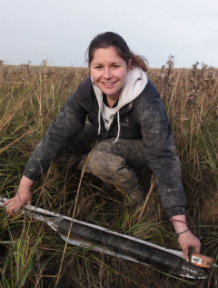Louise Best
PhD Student
Profile
Career
| 2013-present | PhD Student | Department of Environment and Geography, University of York |
| 2011-2012 | MSc (by research) Geography | Department of Geography, Durham University |
| 2008-2011 | BSc (Hons) Geography | Department of Geography, Durham University |
Research
Overview
Description of PhD
Title: Late Holocene sea-level change and saline intrusion, Humber Estuary, UK.
Supervisors: Dr. Katherine Selby and Mark Morton
Funding: Natural Environment Research Council (NERC), Yorkshire Water
TAC: Dr. Katherine Selby, Mark Morton, Dr. David Rippin
Description of thesis:
Louise is interested in Quaternary environmental change, particularly the reconstruction of Holocene sea-levels using micro-fossils. This research is focused on the Holocene sea-level history of the Humber Estuary.
Changing sea-levels are a key concern around the globe due to both the direct and indirect effects on coastal regions and resources. For the Yorkshire region this has resulted in particular concerns over the preservation of potable and plentiful water supplies. Groundwater is abstracted as a source of potable water from the chalk aquifer in close proximity to the Humber Estuary. There is a complex relationship within, and between, groundwater and estuarine coastal processes, and the risk of possible intrusions of saline water into the groundwater source needs to be investigated. This requires a consideration of both the sea-level history of the estuary, as well as the groundwater characteristics of the surrounding region.
Existing sea-level data points for the estuary provide a record of change during the Holocene, however there is a scarcity of data for the most recent ~2000 years. This project aims to establish a high resolution sea-level record for this late Holocene period through litho- and bio-stratigraphical analyses of multiple locations around the estuary. Microfossils, primarily diatoms, will be used as the proxy data to reconstruct former relative sea-levels. This will assist in furthering understanding of the Holocene evolution of the estuary, the implications of saline intrusion into the chalk aquifer, and the consequences of possible future changes. The data can be used in conjunction with groundwater models to inform the decisions, policies and management strategies of the local water authority to safeguard future water supplies for the region
Previous research
Masters thesis: Lake Diatoms as a Proxy for Holocene Environmental Change, West Greenland
Abstract:
There is great interest over the Greenland Ice Sheet in terms of future climate change, though there is a lack of understanding of climate change during the Holocene. Lakes can provide continuous and detailed records of paleoclimate; the distinct taxonomy and preservation potential of diatoms makes them a particularly useful proxy within paleoenvironmental reconstructions. Contemporary diatom assemblages and the environmental conditions of 25 lakes from a localized area in the Godthåbsfjord region, southwest Greenland, as well as a fossil core from one of the lakes, are studied. Multivariate analysis is undertaken to establish the relationships between the contemporary diatoms and environmental conditions, and the addition of another dataset from Søndre Strømfjord, west Greenland, provided an insight into lake and diatom variability. Transfer functions are then developed for several environmental variables, including pH, temperature and lake depth, and applied to the fossil diatom assemblages from the lake core. The fossil diatom assemblages and quantitative reconstructions indicate an acidification of the lake through the Holocene, and the quantitative reconstructions, along with additional proxy data of pollen, provide a record of several warming and cooling phases through the Holocene, including the Little Ice Age. There are however several issues, including multiple forcing variables acting on the contemporary diatoms, the provision of modern analogues for the fossil assemblages, as well as preservation problems, that raise several questions over the reliability of lake diatoms as a proxy for Holocene environmental change in southwest Greenland.
Publications
Full publications list
Best, L.A. (2013) Lake Diatoms as a Proxy for Holocene Environmental Change, West Greenland. Masters thesis, Durham University.

